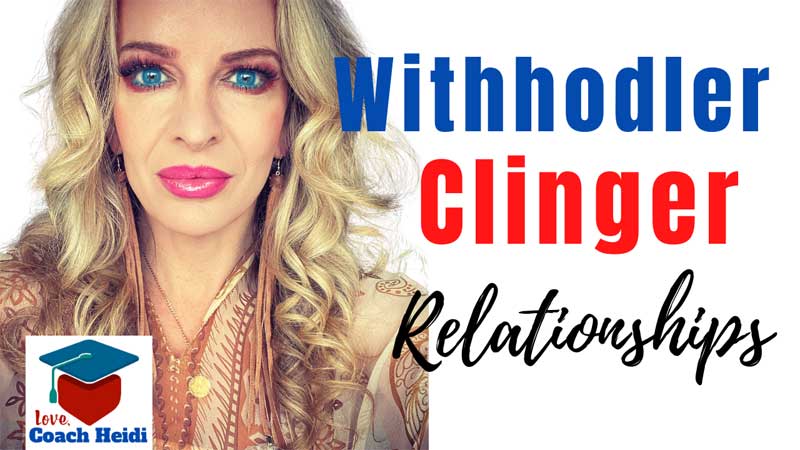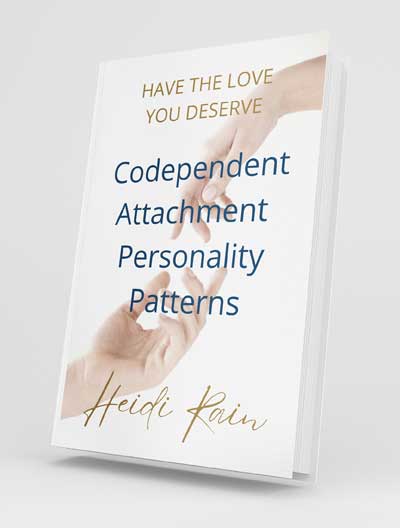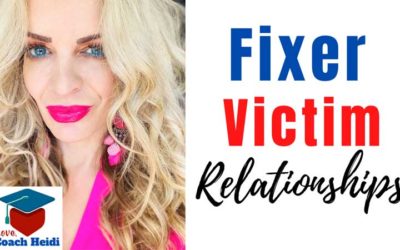Codependent Relationship Clinger and Withholder
I can’t tell you how many times I’ve heard, “I’m mot codependency, but my partner is.”
Codependent is “co”, and we are usually two sides of the same coin, on opposite ends of the spectrum and that is how we attract each other. Because like does attract like, but it’s seemingly opposite. Let me explain what I mean.
Two codependency types that hook up all the time and are a match made in hell, is a Withholder and a Clinger. I’m going to get into these two patterns today and talk about how it shows up and why they hook up and how it happens and how the insanity looks, so that you can have awareness, because insight is the very first step. What we want to do is put that awareness in motion and help you make some massive changes in your life so that you can have the love and relationships that you really, truly deserve. Drama free relationships, right? Where you can be yourself and be loved for exactly who you are and you don’t want to change anything or change anybody else.
Consistency, you’re not confused all the time or full of resentment or overwhelm or pain or anything else that’s stemming from these codependent patterns. As I said, I’m going to talk about the Withholder and the Clinger today. Now I’ve come up with eight different Attachment Personality Patterns. I’ve invented this name: Attachment Personality Patterns and I’ve done it as a result of the almost decade worth of research I did working inside of a dual diagnosis treatment center where people were healing from all types of addiction and codependence. And so I kept seeing these patterns emerge and kind of ran with it.
You can download a copy of my free book, “Attachment Personality Patterns”, Learn More About Codependency Here!
So, let’s get into these two patterns. Withholders are people that are very misunderstood. Because Withholders are very sensitive people, but they learned a long time ago that vulnerability is weakness. So, a Withholder keeps their emotions to themselves. They have a very tough time expressing how they’re feeling, or sometimes they’re so good at not knowing or suppressing their emotions that they don’t know how they feel. When you ask a Withholder how they feel, they’ll say, “I think I feel”. It’s very hard to get them to crack their heart open. They long for intimacy, yet a deeply afraid of it at the same time.
A Withholder longs for intimacy. It’s just that they’re afraid at the core that they’re going to be rejected. They bring people in, but then they kind of keep them at an arms distance. It’s like, come here, but not too close. And so, if you’re in a relationship with a Withholder and you start to get close to them, they will do what I call Distancing Techniques, which is they will invite an argument with you to restore the distance. Their worst fear is getting too close to you, allowing themselves to love you too much, and then being rejected by you.
Withholders want others to love them more than they love others. So, they restrict their emotions, restrict their feelings. They can be very sexually active and intimate that way, but they’ll settle for sex when what they really want is deep intimacy and love. But again, they’re not vulnerable enough to share what they’re thinking or feeling and so that real true intimacy very rarely gets created.
Now, a Clinger Attachment Personality Pattern on the other hand is on the same spectrum with the Withholder. The Clinger is an over-sharer. They go into a relationship and divulge absolutely everything. They fantasize and romanticize and put the person that they’re interested in up on a pedestal.
They are super trusting, where a Withholder trusts no one. The only person a Withholder believes they can trust is themselves. A clinger trusts before trust is deserved.
Another trait of the clinger is they don’t recognize the emotional unavailability of the people they’re attracted to. They don’t recognize that because they project a fantasy onto that person. They really blow up all their good traits and minimize the red flags or deny the red flags because they want love and relationship more than they want to see the reality of that person.
The core fear is abandonment. A Withholder fears rejection, a Clinger fears abandonment.
And so, when they first get together, it is awesome for these two people. It’s a match made in Heaven at first, because a withholder feels relief! “Oh my God, I don’t have to talk. I don’t have to do anything! I don’t have to show my emotions and feelings because this person is doing all the heavy lifting! I mean they are sharing everything all the time. They’re telling me how they feel. They’re sharing their whole life story. So, this is really great.”
And a Clinger is like, “Well, this is really great, because I can just be myself in this relationship and I feel really connected now! They’re letting me do all the talking and they’re so curious about me and my life story! They listen to me and let me go on and on! I feel so heard and loved.”
But the Clinger doesn’t feel connected because the Withholder is really connected to them, they feel connected because they’re doing all the connecting, so they don’t see the red flags.
Now initially, a Withholder won’t go in rejecting this other person, pushing them away right away, because again, a Withholder longs to be close. They get drunk on all the neurotransmitters or wellbeing flooding the brain. That’s why love is blind because we’re all love drunk as hell.
But when the neurotransmitters start to wear off, what happens?
A withholder will start to feel smothered. They’ll feel like the Clinger is too much. They’ll feel as though they can’t breathe, and they need space. can’t breathe. And they’ll start to do things to push that person away, engaging the Distancing Techniques.
But this will trigger the Clinger into more desire for closeness. They’ll try to corner the Withholder, demanding answers. “Tell me how you feel about me. Why are you confused? What are we doing here? Don’t you want me?”
Relationship confusion for a clinger makes them so anxious that they just want to resolve it, so they go harder. Clingers need constant reassurance and approval. And a Withholder will withhold approval, praise, and affection to create distance.
At this point, a Withholder might do something drastic to sabotage the relationship. They may go MIA, ghosting the Clinger. They may even begin another relationship, keeping their options open.
Here’s where things go even worse.
Eventually, a healthier Clinger will let the abandonment settle in and pull back themselves to avoid more hurt. But suddenly, once the Withholder sees this, they will become the Clinger. And then the two Patterns have switched roles.
And the Withholder becomes the Clinger, and the Clinger now becomes the Withholder.
These two Patterns can do this dance of “I hate you, don’t leave. Come here, go away” for decades.
Now maybe at this point, you are thinking, “Oh my God. This woman has literally described my relationship.” Yes. I’ve dedicated my whole life to co-dependence and understanding these patterns and how I can help you can break free.
Awareness is the first step, but what’s the second step?
It’s putting that Awareness In Motion. We AIM for relationship success.
When we work together, you find out if your relationship can work. You will finally answer the questions, “Can this be fixed or saved? Should I stay or should I go?” Once and for all and get off the fence.
Clingers finally stop feeling abandoned when you put your heart and soul into another, and they leave you.
And Withholders stop feeling so misunderstood and learn how to receive and let intimacy in.
And that’s what I want for you, codependency recovery.
The very next step is to schedule a complimentary consultation to learn more about Codependency and Toxic Relationships with our handy dandy button at the top of this page.
I’m looking forward to meeting!
And as always, if you found this helpful, will you share it and pass it along to someone else you know can benefit?
Thank you! I appreciate you!
Heidi Rain






0 Comments